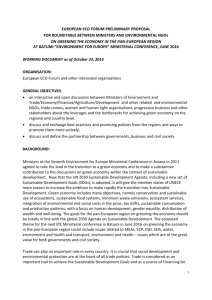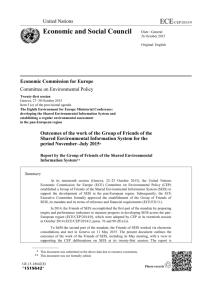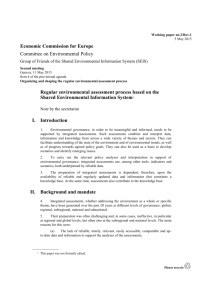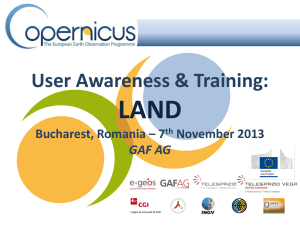ece.cep.2015.10.e
advertisement
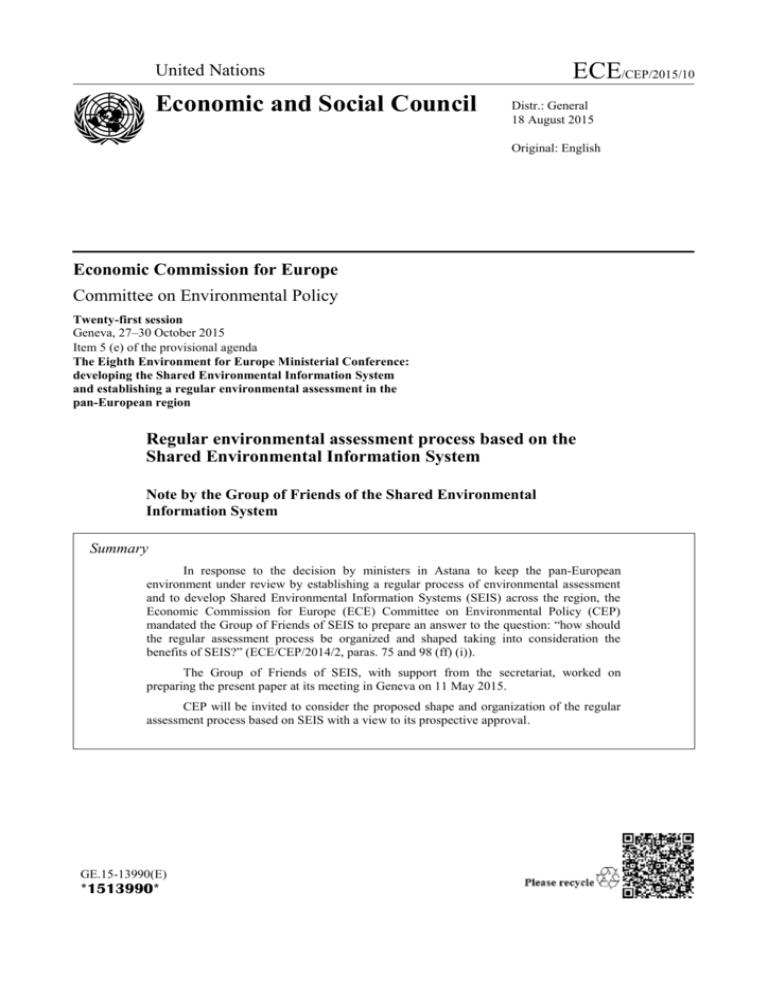
ECE/CEP/2015/10 United Nations Economic and Social Council Distr.: General 18 August 2015 Original: English Economic Commission for Europe Committee on Environmental Policy Twenty-first session Geneva, 27–30 October 2015 Item 5 (e) of the provisional agenda The Eighth Environment for Europe Ministerial Conference: developing the Shared Environmental Information System and establishing a regular environmental assessment in the pan-European region Regular environmental assessment process based on the Shared Environmental Information System Note by the Group of Friends of the Shared Environmental Information System Summary In response to the decision by ministers in Astana to keep the pan-European environment under review by establishing a regular process of environmental assessment and to develop Shared Environmental Information Systems (SEIS) across the region, the Economic Commission for Europe (ECE) Committee on Environmental Policy (CEP) mandated the Group of Friends of SEIS to prepare an answer to the question: “how should the regular assessment process be organized and shaped taking into consideration the benefits of SEIS?” (ECE/CEP/2014/2, paras. 75 and 98 (ff) (i)). The Group of Friends of SEIS, with support from the secretariat, worked on preparing the present paper at its meeting in Geneva on 11 May 2015. CEP will be invited to consider the proposed shape and organization of the regular assessment process based on SEIS with a view to its prospective approval. GE.15-13990(E) *1513990* ECE/CEP/2015/10 I. Introduction 1. Environmental governance, in order to be meaningful and informed, needs to be supported by integrated assessments. Such assessments combine and interpret data, information and knowledge from across a wide variety of themes and sectors. They can facilitate an understanding of the state of the environment and environmental trends, as well as progress towards agreed policy goals. They can also be used as a basis to develop scenarios and identify emerging issues. 2. To carry out the relevant policy analyses and interpretation in support of environmental governance, integrated assessments use, among other tools, indicators and scenarios, both underpinned by reliable data. 3. The preparation of integrated assessments is dependent, therefore, upon the availability of reliable and regularly updated data and information that constitute a knowledge base. At the same time, assessments also contribute to the knowledge base. 4. Integrated assessments, whether addressing the environment as a whole or a specific theme, have been generated over the past 20 years at different levels of governance: global, regional, subregional, national and subnational. 5. The preparation of such assessments has often been challenging, however, and, in some cases, ineffective, in particular at the regional and global levels, but often also at the subregional and national levels. The main reasons for this were: (a) The lack of reliable, timely, relevant, easily accessible, comparable and upto-date data information to support the analyses in the assessments; (b) Insufficient cooperation and exchange of information among the stakeholders, in particular across sectors, leading to various assessment processes being carried out often at the same governance level, which resulted in a duplication of effort or marginalization of relevant information available elsewhere. 6. The ministers of the environment from the pan-European region present at the Seventh Environment for Europe Ministerial Conference (Astana, 21–23 September 2011) recognized the challenges noted above and decided to address them. They committed to establishing a regular process of environmental assessment for the pan-European region1 based on a Shared Environmental Information System (SEIS) — an approach that, with the support of modern technologies such as the Internet, would link all existing data and information flows relevant at the country and international levels in support of the regular environmental assessment process. 7. The United Nations Economic Commission for Europe (ECE) Committee on Environmental Policy (CEP) has been overseeing the efforts taken in the pan-European region to establish a regular environmental assessment process and to develop SEIS. CEP decided to set up a coordination mechanism for SEIS development across the entire ECE region in the form of a Group of Friends of SEIS and entrusted the Group to work on two issues: (a) The preparation of clear targets and performance indicators to monitor and evaluate the development of SEIS in the pan-European region; 1 2 The pan-European region under the Environment for Europe Process covers the full membership of ECE, i.e., the 56 ECE member States. ECE/CEP/2015/10 (b) The organization and shaping of the regular environmental assessment process, taking into consideration the benefits of SEIS (ECE/CEP/2013/2, paras. 38–39). 8. Accordingly, with regard to the first issue, targets and performance indicators were adopted by CEP at its twentieth session in October 2014, based on the proposal made by the Group of Friends of SEIS. The targets and performance indicators will facilitate the monitoring, development and operation of the pan-European SEIS overseen by the ECE Working Group on Environmental Monitoring and Assessment, which has been mandated with these tasks. 9. Regarding the second issue, the Group of Friends of SEIS prepared the present document to propose the organization and shape of the regular environmental assessment process. The elaboration of the document was supported by the ECE secretariat, the United Nations Environment Programme (UNEP) and the European Environment Agency (EEA). 10. The document contains three main parts: (a) An overview of SEIS in action in the pan-European region, as it is being shaped by the Working Group on Environmental Monitoring and Assessment through agreement on its data and information content in support of the integrated assessments (chapter II); (b) Issues for consideration regarding the shape and organization of a regular process of environmental assessment in the pan-European region (chapter III); (c) A proposal on how to shape and organize a regular process of environmental assessment based on SEIS in the region (chapter IV). 11. CEP is invited to consider this document with a view to agreeing the organization and shape of the regular environment assessment process for the pan-European region, taking into consideration the benefits of SEIS. II. Shared Environmental Information System in action 12. As an approach to link relevant data and information in support of integrated assessments, SEIS makes agreed data and information easily available and accessible online. For the pan-European region, the Working Group on Environmental Monitoring and Assessment is defining the data and information content to be made available and accessible. While the content remains a work in progress, the Working Group agreed at its sixteenth session (Istanbul, 16–17 April 2015) that the data and information should allow the measurement of progress towards agreed global and regional priorities in line, as relevant, with global and regional multilateral environmental agreements (MEAs). The agreed priorities are in areas such as air pollution, climate change, chemicals and waste, biodiversity, water, land and soil, energy and green economy. 13. The Working Group further agreed on a first pan-European SEIS development milestone: 67 specific data sets that every country in the pan-European region should aim to make available and accessible online during 2015. These data sets refer to the following priorities: air pollution and ozone depletion (25 data sets); climate change (4 data sets); water (20 data sets); biodiversity (4 data sets); land and soil (2 data sets); energy (4 data sets); and waste (8 data sets). The Working Group is expected to agree on additional data sets for implementation in subsequent years, with a target of 2020 for the pan-European SEIS to be fully operational, based on SEIS targets and performance indicators. In this process, the Working Group is taking into account the developments at various levels of governance to make the data fully compatible across those levels, including, for example, 3 ECE/CEP/2015/10 the review of priority data flows undertaken at the subregional level by EEA and its European Environment Information and Observation Network (Eionet). 14. For the pan-European SEIS, each specific data set should be accompanied by information explaining the data production methodology 2 and how the data should be interpreted. The data sets also need to be up to date for the latest production period and indicate sources of additional information. 15. The Working Group on Environmental Monitoring and Assessment is supported by the ECE secretariat3 and EEA.4 The two organizations, working in tandem, help to review the online availability and accessibility of data and information provided by the countries in the pan-European region under SEIS.5 They thus help to ensure that the pan-European SEIS is managed effectively by the countries in accordance with the SEIS targets and performance indicators. The two organizations, in cooperation with UNEP, also help to ensure that the data and information are compatible with those produced and shared at other governance levels, such as under the Global Environment Outlook (GEO) process led by UNEP. 16. The pan-European SEIS is active and is organizing, regularizing and coordinating the pan-European environmental knowledge base. When it is fully operational, in 2020, it will provide extensive data and information for the generation of assessments, whether for the environment as a whole or for thematic areas. It will also be available to underpin environmental policy development in the pan-European region and the identification of emerging issues at the regional level, as well as for providing regional input to global processes. The pan-European SEIS will also contain, to the degree possible, certain data, mainly quantitative, necessary for reporting to MEAs. It could be complemented with data available through remote sensing, e.g., as collected under the Group on Earth Observations. III. Considerations regarding the shape and organization of a regular process of environmental assessment, based on the Shared Environmental Information System 17. The shape and organization of a regular process of environmental assessment to keep the pan-European environment under review will naturally encompass several layers of environmental (state-of-the-environment and thematic) assessments, all based on SEIS, as follows: (a) The primary layer will include the environmental assessments prepared at the country level; (b) The middle layer will include environmental assessments prepared at the subregional level; 2 3 4 5 4 This information allows the user to understand whether the available data are produced in accordance with agreed international practices and are comparable. For the countries of Eastern Europe, the Caucasus and Central Asia and other pan-European countries not part of Eionet. For Eionet, as orchestrated by EEA. The reporting mechanism through which pan-European countries will evaluate their performance in developing and operating the pan-European SEIS is under development. The mechanism is based on the SEIS targets and performance indicators. The concept for the mechanism foresees that the evaluations are carried out by the countries and are then reviewed by ECE and EEA. ECE/CEP/2015/10 (c) The pan-European layer will include environmental assessments prepared at the regional level. 18. Preparation of assessments at the country level will be conducted in accordance with the national legislation in that regard, which should be in compliance with the provisions of the ECE Convention on Access to Information, Public Participation in Decision-Making and Access to Justice in Environmental Matters (Aarhus Convention), as well as with other international commitments. These assessments will support informed and targeted decisionmaking and policymaking at the country level. 19. Preparation of assessments at the subregional level will be conducted as necessary in line with established practices in a subregion. Such assessments will support informed discussions and identification of common environmental concerns in a subregion, resulting in targeted decision-making and policymaking. 20. Preparation of assessments at the pan-European level will be conducted as necessary to support regional and global discussions. Such assessments will help identify common environmental concerns in the region and decide on responses at the regional level, as well as inform global-level decision-making and policymaking. 21. With an active SEIS at the pan-European level, comparable data and information are made available and accessible online by the countries in the region. These data and information constitute the common pan-European environmental knowledge base to serve in the generation of required assessments. They are used in the assessments to underpin the production of indicators and the development of scenarios for the analysis undertaken as part of integrated assessments at the different levels. 22. The pan-European SEIS, once fully established, will thus enable any individual or organization to generate an assessment that can help address specific environmental and environment-related policy questions and challenges. 23. All relevant actors and stakeholders will be encouraged to use the knowledge established through the pan-European SEIS to generate additional knowledge in terms of states, trends and progress towards policy goals, as well as to model scenarios and outlooks. However, it could be ineffective and inefficient if assessments of a similar nature are prepared in an uncoordinated manner by different groups and communities at the same governance level for the same geographic area. This could be particularly so for assessments to be issued regularly for the pan-European region or to address the recurrent policy questions and challenges linked to the region’s environmental priorities. 24. A coordinated approach should therefore be of common interest, given that the generation of an integrated assessment is resource intensive. 25. Also, environmental governance in the pan-European region would not benefit from multiple uncoordinated assessments developed either for the pan-European environment as a whole (e.g., a pan-European state-of-the-environment assessment) or for a specific thematic area. Multiple assessments of the same nature might instead confuse policy development and weaken environmental governance. 6 26. It would, therefore, be logical to link the various international groups and communities mandated to generate similar assessments, in terms of scope and content, in assessment networks. In terms of a regular review of the pan-European environment, it might be recommendable to put in place a regional network of networks to constitute the 6 At the same time, generation of assessments addressing different policy questions but building on the pan-European SEIS knowledge base would enrich environmental policy development and governance. 5 ECE/CEP/2015/10 pan-European knowledge group to generate the pan-European assessment. Such a regional network should link with the existing networks dealing with thematic assessments, in particular those under MEAs or specific international agendas (e.g., the post-2015 development agenda) or the parts of them that are related to the environment. 27. For the regular review of the pan-European environment, in addition to the national assessments and regional thematic assessments, there are two existing regular assessment processes in particular that need to be considered when generating the pan-European assessment: (a) The EEA-managed subregional process aimed at generating an assessment report covering the region of the EEA member and cooperating countries.7 This assessment report — the EEA state and outlook report — is published every five years and, among other things, feeds into the evaluation of progress achieved by the EU countries in relation to the EU Environmental Action Programmes and other common commitments. The latest edition, The European environment — state and outlook 2015 (SOER 2015), 8 was published in March 2015; (b) The UNEP-managed global process aimed at the generation of GEO reports supported by UNEP Live. The preparation of the sixth edition of GEO (GEO-6) was requested by the United Nations Environmental Assembly (UNEA) in its resolution 1/4 on the science-policy interface. The global assessment is to be based on the findings of regional assessments of each of the six UNEP regions. 9 The regional assessments are based on the established political and institutional processes and mechanisms in each region and engage with regional partners and stakeholders to make maximum use of these processes and mechanisms in the assessment process. The next pan-European GEO Regional Assessment should be ready for submission to the second meeting of UNEA in May 2016 and, pending a decision by CEP, would be launched at the Eighth Environment for Europe Ministerial Conference in Batumi in June 2016.10 The full GEO-6 assessment is expected to be launched at the third meeting of UNEA in 2018. 28. These two processes and the future regular pan-European process are all mandated at the different governance levels. Therefore, an enhanced coordination among the governance levels would be central to achieving the best results. In particular, the pan-European GEO regional assessment process building on the EEA SOER could contribute to, or become, a single pan-European assessment process delivering one regular assessment product on the review of the pan-European environment serving multiple purposes. 29. In view of the above considerations, CEP is invited to consider the proposal contained in chapter IV for establishing the regular process of environmental assessment of the pan-European environment. 7 8 9 10 6 The EEA members are the 28 European Union member States together with Iceland, Liechtenstein, Norway, Switzerland and Turkey. The cooperating countries are the five West Balkan countries: Albania, Bosnia and Herzegovina, Montenegro, Serbia and the former Yugoslav Republic of Macedonia, as well as Kosovo (United Nations administered region, Security Council Resolution 1244 (1999)). EEA, Copenhagen. Available from www.eea.europa.eu/soer. The pan-European GEO Regional Assessment covers all of the countries in the ECE region, with the exception of North America. . As recommendation by participants at the Regional Environmental Information Network Conference (Istanbul, 13–15 April 2015). ECE/CEP/2015/10 IV. Establishing a regular process of environmental assessment in the pan-European region to keep the pan-European environment under review 30. It is proposed to establish a regular process of environmental assessment in the pan-European region based on the four components presented in sections A-D below. A. Assessment basis 31. The basis for the regular process of environmental assessment in the pan-European region will constitute the following: (a) The pan-European SEIS will serve as the common pan-European environmental knowledge base for the generation of assessments commissioned at the pan-European level; (b) The environmental knowledge base in the region will be updated annually under the pan-European SEIS.11 It will continue to grow in the period until 2020, when the pan-European SEIS should be fully operational. It will be adjusted as necessary to include new types of data and information relevant to policy development beyond 2020; (c) The knowledge base created through SEIS will use, where available, existing technical infrastructure and platforms. UNEP Live should serve as the main platform at the pan-European level, linking with national and subregional platforms and providing centralized access to the knowledge base, including assessments, the data and information regularly published by countries. B. Assessment governance 32. The governance structure will be as follows: (a) The political oversight of the regular review of the pan-European environment and the commissioning of assessments at the pan-European level will be provided by CEP, which will also coordinate its decisions with those taken at the global level related to environmental assessments, in particular those taken by UNEA regarding the GEO process and products; (b) The lead in the generation of the pan-European regular environmental assessments, as mandated by CEP, will be provided by the ECE Working Group on Environmental Monitoring and Assessment, which will also serve as the regional environmental information and assessment network of networks, bringing together the UNEP GEO expert teams and the EEA Eionet to formulate the regional priorities and scope for the pan-European assessments. The Working Group would also link with thematic networks, including those under the MEAs; (c) For the pan-European regular environmental assessments, the Working Group on Environmental Monitoring and Assessment will be serviced and supported by ECE in cooperation with UNEP and EEA. 11 Data and information under the pan-European SEIS are to be updated annually, unless a different cycle has been decided for any particular data flow. The periodicity for the generation of the national environmental assessment report is individually decided by countries. It should, however, be in line with the requirements of the Aarhus Convention. 7 ECE/CEP/2015/10 C. Assessment product 33. The assessment will result in the following product: (a) The GEO pan-European Regional Assessment will become a single pan-European assessment product for the review of the pan-European environment as a whole, serving multiple purposes; (b) The pan-European assessment will build on the EEA SOER and other regional thematic assessments, as well as national assessments. D. Assessment timing 34. The following timing is proposed for the assessment: (a) The pan-European assessment will be generated as a response to demands from the political level, to be confirmed with a decision by CEP. Such a demand could come from the GEO process or other environment-related processes; (b) High-level conferences focusing on the state of environmental affairs and progress made towards established goals and priorities in the environmental sphere will offer suitable occasions for the launch of the pan-European assessments; (c) Generation of the pan-European assessments will not require any synchronization with assessment cycles, other than the GEO cycle. At the same time, the process will be kept informed of the knowledge generated in those other processes, whether thematic assessments or the EEA SOERs. 8
